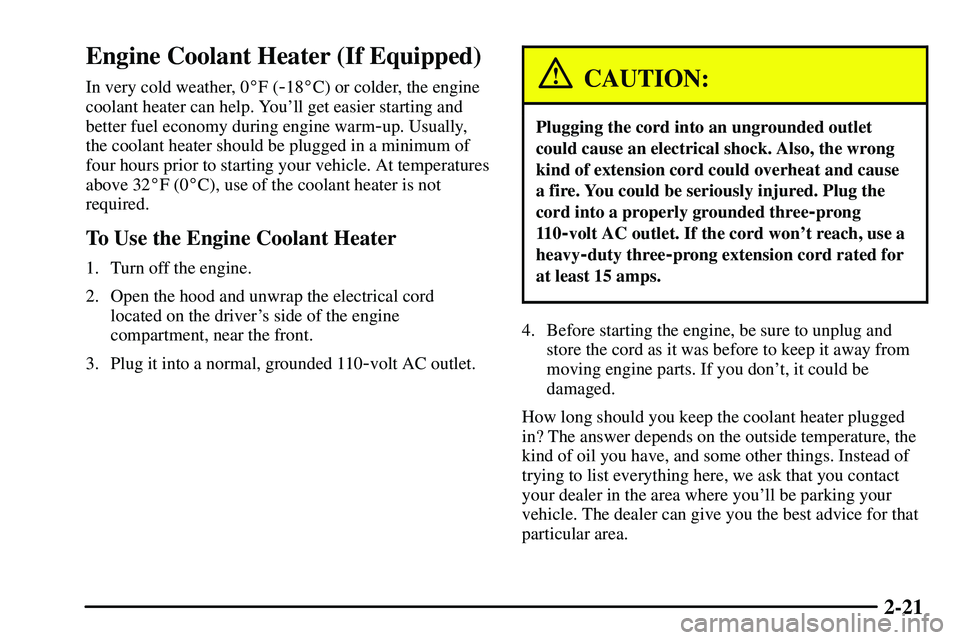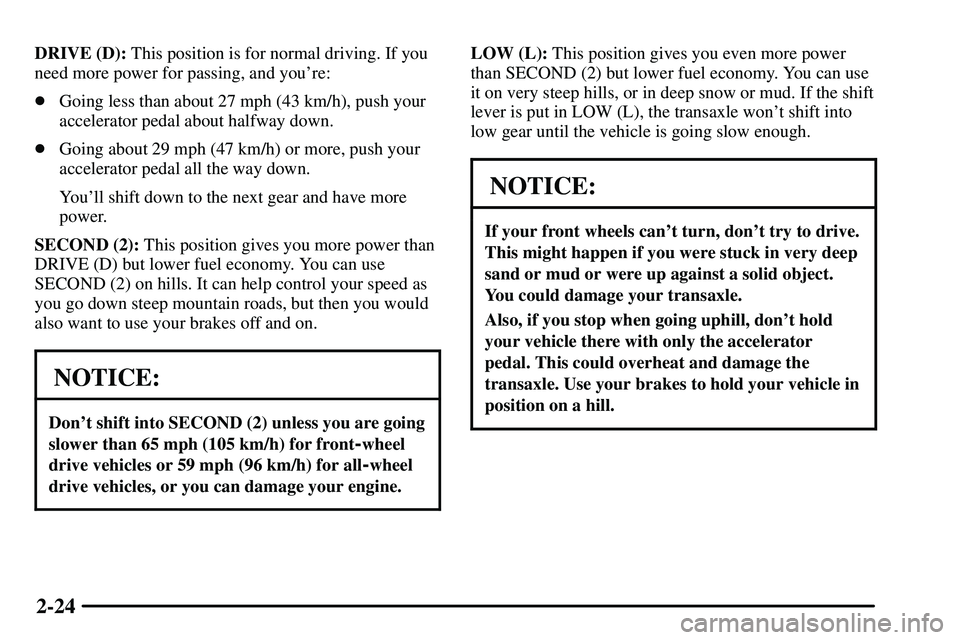Page 85 of 381

2-21
Engine Coolant Heater (If Equipped)
In very cold weather, 0�F (-18�C) or colder, the engine
coolant heater can help. You'll get easier starting and
better fuel economy during engine warm
-up. Usually,
the coolant heater should be plugged in a minimum of
four hours prior to starting your vehicle. At temperatures
above 32�F (0�C), use of the coolant heater is not
required.
To Use the Engine Coolant Heater
1. Turn off the engine.
2. Open the hood and unwrap the electrical cord
located on the driver's side of the engine
compartment, near the front.
3. Plug it into a normal, grounded 110
-volt AC outlet.
CAUTION:
Plugging the cord into an ungrounded outlet
could cause an electrical shock. Also, the wrong
kind of extension cord could overheat and cause
a fire. You could be seriously injured. Plug the
cord into a properly grounded three
-prong
11 0
-volt AC outlet. If the cord won't reach, use a
heavy
-duty three-prong extension cord rated for
at least 15 amps.
4. Before starting the engine, be sure to unplug and
store the cord as it was before to keep it away from
moving engine parts. If you don't, it could be
damaged.
How long should you keep the coolant heater plugged
in? The answer depends on the outside temperature, the
kind of oil you have, and some other things. Instead of
trying to list everything here, we ask that you contact
your dealer in the area where you'll be parking your
vehicle. The dealer can give you the best advice for that
particular area.
Page 88 of 381

2-24
DRIVE (D): This position is for normal driving. If you
need more power for passing, and you're:
�Going less than about 27 mph (43 km/h), push your
accelerator pedal about halfway down.
�Going about 29 mph (47 km/h) or more, push your
accelerator pedal all the way down.
You'll shift down to the next gear and have more
power.
SECOND (2): This position gives you more power than
DRIVE (D) but lower fuel economy. You can use
SECOND (2) on hills. It can help control your speed as
you go down steep mountain roads, but then you would
also want to use your brakes off and on.
NOTICE:
Don't shift into SECOND (2) unless you are going
slower than 65 mph (105 km/h) for front
-wheel
drive vehicles or 59 mph (96 km/h) for all
-wheel
drive vehicles, or you can damage your engine.
LOW (L): This position gives you even more power
than SECOND (2) but lower fuel economy. You can use
it on very steep hills, or in deep snow or mud. If the shift
lever is put in LOW (L), the transaxle won't shift into
low gear until the vehicle is going slow enough.
NOTICE:
If your front wheels can't turn, don't try to drive.
This might happen if you were stuck in very deep
sand or mud or were up against a solid object.
You could damage your transaxle.
Also, if you stop when going uphill, don't hold
your vehicle there with only the accelerator
pedal. This could overheat and damage the
transaxle. Use your brakes to hold your vehicle in
position on a hill.
Page 89 of 381

2-25 Overdrive
Your automatic transaxle
has an O/D (overdrive off)
button. It is located on the
left side of the shift lever.
Press the O/D button to turn off overdrive. A light on the
instrument panel cluster will come on when this feature
is used. Press the button again to turn overdrive back on.
Then the light on the instrument panel cluster will go
off. See ªOverdrive Off Lightº in the Index.
Use this feature for better fuel economy. Fast starts
use the most fuel while gradual starts give you the
best fuel economy.
When you turn on your vehicle the overdrive will
automatically be on until you turn it off.
Manual Transaxle Operation
Five-Speed
FIRST (1): Press the
clutch pedal and shift into
FIRST (1). Then, slowly
let up on the clutch pedal
as you press the
accelerator pedal.
Five
-Speed Transaxle
Shift Pattern
You can shift into FIRST (1) when you're going less
than 20 mph (32 km/h). If you've come to a complete
stop and it's hard to shift into FIRST (1), put the shift
lever in neutral and let up on the clutch. Press the clutch
pedal back down. Then shift into FIRST (1).
SECOND (2): Press the clutch pedal as you let up on
the accelerator pedal and shift into SECOND (2). Then,
slowly let up on the clutch pedal as you press the
accelerator pedal.
Page 92 of 381
2-28 Shift Speeds
CAUTION:
If you skip a gear when you downshift, you could
lose control of your vehicle. You could injure
yourself or others. Don't shift down more than
one gear at a time when you downshift.
This chart shows when to shift to the next gear for the
best fuel economy.Manual Transmission Recommended Shift Speeds
ENGINE1 to 2 or
2 to 12 to 3 or
3 to 23 to 4 or
4 to 34 to 5 or
5 to 4
1.8 L
(Code 8)15 mph
(24 km/h)25 mph
(40 km/h)40 mph
(64 km/h)45 mph
(72 km/h)
ENGINE1 to 2 or
2 to 12 to 3 or
3 to 23 to 4 or
4 to 34 to 5 or
5 to 45 to 6 or
6 to 5
1.8 L
(Code L)15 mph
(24 km/h)25 mph
(40 km/h)40 mph
(64 km/h)45 mph
(72 km/h)50 mph
(80 km/h)
If your speed drops below 20 mph (32 km/h), or if the
engine is not running smoothly, you should downshift to
the next lower gear. You may have to downshift two or
more gears to keep the engine running smoothly or for
good performance.
Page 124 of 381
2-60
Instrument Panel Cluster
Your instrument panel is designed to let you know at a glance how your vehicle is running. You'll know how fast
you're going, how much fuel is left in the tank and many other things you'll need to drive safely and economically.
United States Cluster Shown, Canada Similar
Page 132 of 381

2-68
Canada
This gage shows the engine coolant temperature. If the
gage pointer moves into the red area, your engine is too
hot! It means that your engine has overheated. If you
have been operating your vehicle under normal driving
conditions, you should pull off the road, stop your
vehicle and turn off the engine as soon as possible.
In ªProblems on the Road,º this manual shows what to
do. See ªEngine Overheatingº in the Index.
Malfunction Indicator Lamp
(Check Engine Light)
United States Canada
Your vehicle is equipped with a computer which
monitors operation of the fuel, ignition and emission
control systems.
This system is called OBD II (On
-Board
Diagnostics
-Second Generation) and is intended to
assure that emissions are at acceptable levels for the life
of the vehicle, helping to produce a cleaner
environment. The CHECK ENGINE light comes on to
indicate that there is a problem and service is required.
Malfunctions often will be indicated by the system
before any problem is apparent. This may prevent more
serious damage to your vehicle. This system is also
designed to assist your service technician in correctly
diagnosing any malfunction.
Page 133 of 381

2-69
NOTICE:
If you keep driving your vehicle with this light
on, after a while, your emission controls may not
work as well, your fuel economy may not be as
good and your engine may not run as smoothly.
This could lead to costly repairs that may not be
covered by your warranty.
NOTICE:
Modifications made to the engine, transaxle,
exhaust, intake or fuel system of your vehicle or
the replacement of the original tires with other
than the proper matching tires can affect your
vehicle's emission controls and may cause this
light to come on. Modifications to these systems
could lead to costly repairs not covered by your
warranty. This may also result in a failure to pass
a required Emission Inspection/Maintenance test.
This light should come on, as a check to show you it is
working, when the ignition is on and the engine is not
running. If the light doesn't come on, have it repaired.
This light will also come on during a malfunction in one
of two ways:
�Light Flashing
-- A misfire condition has been
detected. A misfire increases vehicle emissions and
may damage the emission control system on your
vehicle. Dealer or qualified service center diagnosis
and service may be required.
�Light On Steady
-- An emission control system
malfunction has been detected on your vehicle.
Dealer or qualified service center diagnosis and
service may be required.
Page 134 of 381

2-70
If the Light Is Flashing
The following may prevent more serious damage to
your vehicle:
�Reducing vehicle speed.
�Avoiding hard accelerations.
�Avoiding steep uphill grades.
�If you are towing a trailer, reduce the amount of
cargo being hauled as soon as it is possible.
If the light stops flashing and remains on steady, see ªIf
the Light Is On Steadyº following.
If the light continues to flash, when it is safe to do so,
stop the vehicle. Find a safe place to park your vehicle.
Turn the key off, wait at least 10 seconds and restart the
engine. If the light remains on steady, see ªIf the Light
Is On Steadyº following. If the light is still flashing,
follow the previous steps, and drive the vehicle to your
dealer or qualified service center for service.If the Light Is On Steady
You may be able to correct the emission system
malfunction by considering the following:
Did you recently put fuel into your vehicle?
If so, reinstall the fuel cap, making sure to fully install
the cap. See ªFilling Your Tankº in the Index. The
diagnostic system can determine if the fuel cap has been
left off or improperly installed. A loose or missing fuel
cap will allow fuel to evaporate into the atmosphere. A
few driving trips with the cap properly installed should
turn the light off.
Did you just drive through a deep puddle of water?
If so, your electrical system may be wet. The condition
will usually be corrected when the electrical system
dries out. A few driving trips should turn the light off.
Are you low on fuel?
As your engine starts to run out of fuel, your engine may
not run as efficiently as designed since small amounts of
air are sucked into the fuel line causing a misfire. The
system can detect this. Adding fuel should correct this
condition. Make sure to install the fuel cap properly. See
ªFilling Your Tankº in the Index. It will take a few
driving trips to turn the light off.